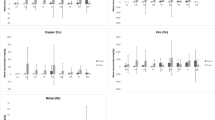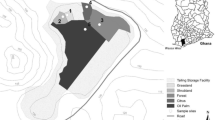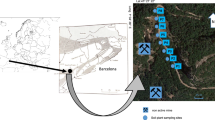Abstract
Mining activities generate spoils and effluents with extremely high metal concentrations of heavy metals that might have adverse effects on ecosystems and human health. Therefore, information on soil and plant metal concentrations is needed to assess the severity of the pollution and develop a strategy for soil reclamation such as phytoremediation. Here, we studied soils and vegetation in three heavily contaminated sites with potential toxic metals and metalloids (Zn, Pb, Cd, As, TI) in the mining district of Les Malines in the Languedoc region (southern France). Extremely high concentrations were found at different places such as the Les Aviniéres tailing basins (up to 160,000 mg kg–1 Zn, 90,000 mg kg–1 Pb, 9,700 mg kg–1 of As and 245 mg kg–1 of Tl) near a former furnace. Metal contamination extended several kilometres away from the mine sites probably because of the transport of toxic mining residues by wind and water. Spontaneous vegetation growing on the three mine sites was highly diversified and included 116 plant species. The vegetation cover consisted of species also found in non-contaminated soils, some of which have been shown to be metal-tolerant ecotypes (Festuca arvernensis, Koeleria vallesiana and Armeria arenaria) and several Zn, Cd and Tl hyperaccumulators such as Anthyllis vulneraria, Thlaspi caerulescens, Iberis intermedia and Silene latifolia. This latter species was highlighted as a new thallium hyperaccumulator, accumulating nearly 1,500 mg kg–1. These species represent a patrimonial interest for their potential use for the phytoremediation of toxic metal-polluted areas.





Similar content being viewed by others
Notes
For ease and convenience, both metals and metalloids are hereafter referred to as metals.
References
AFNOR. (1996). Qualité des sols. Recueil de normes françaises. Paris: AFNOR.
Amphoux, G., & Laroche, D. (1989). La mine des Malines. Paysage-Actualités, 122, 115–121.
Antonovics, J., Bradshaw, A. D., & Turner, R. G. (1971). Heavy metal tolerance in plants. Advances in Ecological Research, 7, 1–85.
Assuncao, A. G. L., Bookum, W. M., Nelissen, H. J. M., Vooijs, R., Schat, H., & Ernst, W. H. O. (2003). Differential metal-specific tolerance and accumulation patterns among Thlaspi caerulescens populations originating from different soil types. The New Phytologist, 159, 411–419.
Audry, S., Blanc, G., & Schafer, J. (2004). Cadmium transport in the Lot-Garonne River system (France) – temporal variability and a model for flux estimation. The Science of the Total Environment, 319, 197–213.
Bailly-Maître, M. C. (1997). La mine au Moyen Age. La gestion de l'espace souterrain, Mélange Cl. Domergue. Pallas, 46, 287–295.
Baize, D. (1997). Teneurs totales en éléments traces métalliques dans les sols (France). Références et stratégies d'interprétation (p. 410 p). Paris: INRA Éditions.
Baker, A. J. M., & Walker, P. L. (1990). Ecophysiology of metal uptake by tolerant plants. In A. J. Shaw (Ed.), Heavy metal tolerance in plants: evolutionary aspects (pp. 155–177). Boca Raton: CRC Press.
Baker, A. J. M., McGrath, S. P., Reeves, R. D., & Smith, J. A. C. (2000). Metal hyperaccumulator plants: a review of the ecology and physiology of a biochemical resource for phytoremediation of metal-polluted soils. In N. Terry & G. Bañuelos (Eds.), Phytoremediation of Contaminated Soil and Water (pp. 85–107). Boca Raton: Lewis Publishers.
Balabane, M., Faivre, D., van Oort, F., & Dahmani-Muller, H. (1999). Mutual effects of organic matter dynamics and heavy metal fate in a metallophyte grassland. Environmental Pollution, 105, 45–54.
Bert, V., MacNair, M. R., DeLaguerie, P., SaumitouLaprade, P., & Petit, D. (2000). Zinc tolerance and accumulation in metallicolous and nonmetallicolous populations of Arabidopsis halleri (Brassicaceae). The New Phytologist, 146, 225–233.
Beyer, W. N. (1988). Damage to the forest ecosystem on Blue Mountain from zinc smelting. Trace Substances in Environmental Health, 22, 249–262.
Bouladon, J. (1977). Les gisements de plomb-zinc-argent du Massif Central. Bulletin du BRGM, Section II, 67–90.
Bradshaw, A. D., & Chadwick, M. J. (1980). The restoration of land (p. 317). Oxford: Blackwell.
Brown, S. L., Chaney, R. L., Angle, J. S., & Baker, A. J. M. (1995). Zinc and cadmium uptake by hyperaccumulator Thlaspi caerulescens grown in nutrient solution. Soil Science Society of America Journal, 59, 125.
Cicchelero, V. (2006) Dépistage du saturnisme dans la commune de Saint-Laurent-le-Minier (Gard), mai 2005. Unpublished report with the participation of: Institut de Veille Sanitaire, Cellule interrégionale d'épidémiologie Languedoc-Roussillon, Préfecture de Région de Midi Pyrénées, Direction Départementale des Affaires Sanitaires et Sociales de Gard.
Cottenie, A., Verloo, M., Kiekens, L., Velghe, G., Camerlynck, R. (1982). Chemical analysis of plants and soils. Laboratory of analytical and agrochemistry, State University Ghent, Belgium. p.63
Cunningham, S. D., & Berti, W. R. (2000). Phytoextraction and phytostabilization: technical, economic, and regulatory considerations of the soil-lead issue. In N. Terry & G. Bañuelos (Eds.), Phytoremediation of Contaminated Soil and Water (pp. 359–376). Boca Raton: Lewis Publishers.
Dahmani-Muller, H., van Oort, F., Gelie, B., & Balabane, M. (2000). Strategies of heavy metal uptake by three plant species growing near a metal smelter. Environmental Pollution, 109, 231–238.
De Cáceres, M., Font, X., García, R., Oliva, F. (2003). Vegana, un paquete de programas para la gestión y análisis de datos ecológicos. VII Congreso Nacional de la Asociación Española de Ecología Terrestre. Barcelona, Spain. pp. 1481–1497
Dère, C., Lamy, I., van Oort, F., Baize, D., & Cornu, S. (2006). Reconstitution des apports en éléments traces métalliques et bilan de leur migration dans un Luvisol sableux soumis à 100 ans d'irrigation massive par des eaux usées brutes. Comptes Rendus Geosciences, 338, 565–573.
Douay, F., Pruvot, C., Roussel, H., Ciesielski, H., Fourrier, H., Proix, N., et al. (2008). Contamination of urban soils in an area of Northern France polluted by dust emissions of two smelters. Water, Air, and Soil Pollution, 188, 247–260.
Ernst, W. H. O. (1974). Schwermetallvegetation der Erde. Stuttgart: Gustav Fischer Verlag.
Ernst, W. H. O. (1996). Bioavailability of heavy metals and decontamination of soils by plants. Applied Geochemistry, 11, 163–167.
Escarré, J., Houssard, C., Debussche, M., & Lepart, J. (1983). Evolution de la végétation et du sol après abandon cultural en région méditerranéenne: étude de succession dans la garrigues du Montpelliérais (France). Acta Oecologica, Oecologia Plantarum, 4, 221–239.
Escarré, J., Lefèbvre, C., Gruber, W., Leblanc, M., Lepart, J., Rivière, Y., et al. (2000). Zinc and cadmium hyperaccumulation by Thlaspi caerulescens from metalliferous and nonmetalliferous sites in the Mediterranean area: implications for phytoremediation. The New Phytologist, 145, 429–437.
Fangueiro, D., Bermond, A., Santos, E., Carapuça, H., & Duarte, A. (2005). Kinetic approach to heavy metal mobilization assessment in sediments: choose of kinetic equations and models to achieve maximum information. Talanta, 66, 844–857.
FAO. (2006). Guidelines for soil profile description (4th ed.). Rome: F.A.O.
Fernandez, C., Labanowski, J., Cambier, P., Jongmans, A. G., & van Oort, F. (2007). Fate of airborne metal pollution in soils as related to agricultural management. 1. Zn and Pb distribution in soil profiles. European Journal of Soil Science, 58, 547–559.
Freitas, H., Prasad, M. N. V., & Pratas, J. (2004). Analysis of serpentinophytes from north-east of Portugal for trace metal accumulation - relevance to the management of mine environment. Chemosphere, 54, 1625–1642.
Frérot, H., Lefèbvre, C., Gruber, W., Collin, C., Dos Santos, A., & Escarré, J. (2006). Specific interactions between local metallicolous plants improve the phytostabilization of mine soils. Plant and Soil, 282, 53–65.
Frérot, H., Lefèbvre, C., Petit, C., Collin, C., Dos Santos, A., & Escarré, J. (2005). Zinc tolerance and hyperaccumulation in F-1 and F-2 offspring from intra and interecotype crosses of Thlaspi caerulescens. The New Phytologist, 165, 111–119.
Frérot, H., Lefèbvre, C., Petit, C., Collin, C., DosSantos, A., & Escarre, J. (2009). Adaptation des végétaux aux milieux pollués par des métaux toxiques et phytoremédiation-cas de la région Languedoc-Roussillon. In P. Cambier et al. (Eds.), Contaminations métalliques des agrosystèmes et écosystèmes péri-industriels (pp. 287–298). Versailles: Editions Quae.
Frérot, H., Petit, C., Lefèbvre, C., Gruber, W., Collin, C., & Escarré, J. (2003). Zinc and cadmium accumulation in controlled crosses between metallicolous and nonmetallicolous populations of Thlaspi caerulescens (Brassicaceae). The New Phytologist, 157, 643–648.
Gabler, H. E., & Schneider, J. (2000). Assessment of heavy-metal contamination of floodplain soils due to mining and mineral processing in the Harz Mountains, Germany. Environmental Geology, 39, 774–782.
Grimalt, J. O., Ferrer, M., & Macpherson, E. (1999). The mine tailing accident in Aznalcollar. The Science of the Total Environment, 242, 3–11.
Holl, K. D. (2002). Effect of shrubs on tree seedling establishment in an abandoned tropical pasture. Journal of Ecology, 90, 179–187.
Holmgren, G. G. S., Meyer, M. W., Chaney, R. L., & Daniels, R. B. (1993). Cadmium, lead, zinc, copper, and nickel in agricultural soils of the United States of America. Journal of Environmental Quality, 22, 335–348.
Labanowski, J., Monna, F., Bermond, A., Cambier, P., Fernandez, C., Lamy, I., et al. (2008). Kinetic extractions to assess mobilization of Zn, Pb, Cu, and Cd in a metal-contaminated soil: EDTA vs. citrate. Environmental Pollution, 153, 693–701.
Leach, D., Macquar, J. C., Lagneau, V., Leventhal, J., Emsbo, P., & Premo, W. (2006). Precipitation of lead-zinc ores in the Mississippi Valley-type deposit at Trèves, Cévennes region of southern France. Geofluids, 6, 24–44.
Leblanc, M., Petit, D., Deram, A., Robinson, B. H., & Brooks, R. R. (1999). The phytomining and environmental significance of hyperaccumulation of thallium by Iberis intermedia from Southern France. Economic Geology And The Bulletin Of The Society Of Economic Geologists, 94, 109–113.
Lefebvre, C. (1974). Population variation and taxonomy in Armeria-Maritima with special reference to heavy-metal-tolerant populations. The New Phytologist, 73, 209–219.
Lefèbvre, C., & Simon, E. (1979). Plant spacing in open communities from old zinc-lead mines wastes. Oecologia Plantarum, 14, 461–474.
Lefèbvre, C., & Vernet, P. (1990). Microevolutionary processes on contaminated deposits. In A. J. Shaw (Ed.), Heavy metal tolerance in plants: Evolutionary aspects (pp. 285–300). Boca Raton: CRC Press Inc.
Liu, M. Q., Yanai, J. T., Jiang, R. F., Zhang, F., McGrath, S. P., & Zhao, F. J. (2008). Does cadmium play a physiological role in the hyperaccumulator Thlaspi caerulescens? Chemosphere, 71, 1276–1283.
Lombi, E., Zhao, F. J., McGrath, S. P., Young, S. D., & Sacchi, G. A. (2001). Physiological evidence for a high-affinity cadmium transporter highly expressed in a Thlaspi caerulescens ecotype. The New Phytologist, 149, 53–60.
Meerts, P., & Van Isacker, N. (1997). Heavy metal tolerance and accumulation in metallicolous and non-metallicolous populations of Thlaspi caerulescens from continental Europe. Plant Ecology, 133, 221–231.
Ministère de la Santé. (2004). Circulaire DGS/SD7A no 45 du 5 février 2004 relative au contrôle des paramètres plomb, cuivre et nickel dans les eaux destinées à la consommation humaine.
Molitor, M., Dechamps, C., Gruber, W., & Meerts, P. (2005). Thlaspi caerulescens on nonmetalliferous soil in Luxembourg: ecological niche and genetic variation in mineral element composition. The New Phytologist, 165, 503–512.
Noret, N., Meerts, P., Vanhaelen, M., Dos Santos, A., & Escarre, J. (2007). Do metal-rich plants deter herbivores? A field test of the defence hypothesis. Oecologia, 152, 92–100.
Petelet-Giraud, E., Negrel, P., Luck, J. M., & Ben Othman, D. (2004). Dissolved and particulate heavy metals transport in the Herault watershed: constraints of the origin by lead isotopes. Houille Blanche-Revue Internationale De L Eau, 2, 43–48.
Remon, E., Bouchardon, J. L., Cornier, B., Guy, B., Leclerc, J. C., & Faure, O. (2005). Soil characteristics, heavy metal availability and vegetation recovery at a former metallurgical landfill: Implications in risk assessment and site restoration. Environmental Pollution, 137, 316–323.
Retana, J., Espelta, J. M., Habrouk, A., Ordonez, J. L., & de Sola Morales, F. (2002). Regeneration patterns of three Mediterranean pines and forest changes after a large wildfire in northeastern Spain. Ecoscience, 9, 89–97.
Robinson, B., Leblanc, M., Petit, D., Brooks, R., Kirkman, J., & Gregg, P. (1998). The potential of Thlaspi caerulescens for phytoremediation of contaminated soils. Plant and Soil, 203, 47–56.
Robles-Arenas, V. M., Rodriguez, R., Garcia, C., Manteca, J. I., & Candela, L. (2006). Sulphide-mining impacts in the physical environment: Sierra de Cartagena La Union (SE Spain) case study. Environmental Geology, 51, 47–64.
Rolley, J. P. (2002). La petite histoire du Plomb et du Zinc en Cévennes. Available at: http://www.ensm-ales.fr/~jprolley/Geologie/Pb-Zn.html. Accessed 25 October 2005.
Roosens, N., Verbruggen, N., Meerts, P., Ximenez-Embun, P., & Smith, J. A. C. (2003). Natural variation in cadmium tolerance and its relationship to metal hyperaccumulation for seven populations of Thlaspi caerulescens from western Europe. Plant, Cell & Environment, 26, 1657–1672.
SAS. (2004). SAS-STAT® 9.1 User's guide (pp. 1731–1846). Cary: SAS Institute Inc.
Searcy, K. B., & Mulcahy, D. L. (1985). The parallel expression of metal tolerance in pollen and sporophytes of Silene-Dioica (L) Clairv, Silene-Alba (Mill) Krause and Mimulus-Guttatus Dc. Theoretical and Applied Genetics, 69, 597–602.
Shen, Z. G., Zhao, F. J., & McGrath, S. P. (1997). Uptake and transport of zinc in the hyperaccumulator Thlaspi caerulescens and the non-hyperaccumulator Thlaspi ochroleucum. Plant, Cell & Environment, 20, 898–906.
Shimwell, D. W., & Laurie, A. E. (1972). Lead and zinc contamination of vegetation in the Southern Pennines. Environmental Pollution, 3, 291–301.
Simon, E. (1978). Heavy metals in soils, vegetation development and heavy metal tolerance in plant populations from metalliferous areas. The New Phytologist, 81, 175–188.
Sterckeman, T., Douay, F., Proix, N., Fourrier, H., & Perdrix, E. (2002). Assessment of the contamination of cultivated soils by eighteen trace elements around smelters in the north of France. Water, Air, and Soil Pollution, 135, 173–194.
Tamm, O. (1922). Eine methode zur Bestimmung der anorganischen Komponenten der gelkomplexen in Boden. Meddelanden fran Statens Skogsförsöksanstalt, 19, 385–404.
Terry, N., & Bañuelos, G. (Eds.). (2000). Phytoremediation of contaminated soil and water (pp. 109–128). Boca Raton, FL: Lewis Publishers.
Tremel, A., Masson, P., Garraud, D., Donard, O. F. X., Baize, D., & Mench, M. (1997). Thallium in French agrosystems. II. Concentration of thallium in field-grown rape and some other plant species. Environmental Pollution, 97, 161–168.
Tutin, T. G., Burges, N. A., Chater, A. O., Edmondson, J. R., Heywood, V. H., Moore, D. M., et al. (1964). Flora Europaea. Cambridge: Cambridge University Press.
van Oort, F., Dahmani-Muller, H., Balabane, M., Denaix, L., Gélie, B. (2000) Etude de trois espèces végétales métallophytes : quantification, localisation et spéciation du Zn, Pb et Cd à différentes échelles. II. Evaluation de la faisabilité d'application à la réhabilitation de sols pollués. Final Report Convention Ademe. INRA No 98 95 005. p. 78
van Oort, F., Thiry, M., Jongmans, A., Bourennane, H., Cambier, P., Lamy, I., et al. (2009). Les pollutions métalliques d'un site industriel et des sols environnants: Distributions hétérogènes des métaux et relations avec l'usage des sols. In P. Cambier, C. Schvartz & F. van Oort (Eds.), Contaminations métalliques des agrosystèmes et écosystèmes péri-industriels. Versailles: Editions Quae. pp. 15–44
Vesk, P. A., & Reichman, S. M. (2009). Hyperaccumulators and herbivores—a Bayesian meta-analysis of feeding choice trials. Journal of Chemical Ecology, 35, 289–296.
Vidal, C., Chantreuil, C., Berge, O., Mauré, L., Escarré, J., Béna, G., et al. (2009). Mesorhizobium metallidurans sp. nov., a novel metal-resistant symbiont of Anthyllis vulneraria growing on metallicolous soil in Languedoc, France. International Journal of Systematic and Evolutionary Microbiology, 59, 850–855.
Vincent, M. (2006). Les mines des Cévennes. Histoire des concessions et des chemins de fer miniers. Association Terre Cévenole.
Vitousek, P., D’Antonio, C., Loope, L., Rejmanek, M., & Westbrooks, R. (1997). Introduced species: a significant component of human-caused global change. New Zealand Journal of Ecology, 21, 1–16.
Wali, M. K. (1999). Ecological succession and the rehabilitation of disturbed terrestrial ecosystems. Plant and Soil, 213, 195–220.
Wiegleb, G., & Felinks, B. (2001). Predictability of early stages of primary succession in post-mining landscapes of Lower Lusatia, Germany. Applied Vegetation Science, 4, 5–18.
Wierzbicka, M., & Pielichowska, M. (2004). Adaptation of Biscutella laevigata L, a metal hyperaccumulator, to growth on a zinc-lead waste heap in southern Poland—I: Differences between waste-heap and mountain populations. Chemosphere, 54, 1663–1674.
Wierzbicka, M., Szarek-Lukaszewska, G., & Grodzinska, K. (2004). Highly toxic thallium in plants from the vicinity of Olkusz (Poland). Ecotoxicology and Environmental Safety, 59, 84–88.
Acknowledgements
The authors thank Guy Delmot for authorising the work at the Les Avinières site and for his kind hospitality. We also thank Perrine Gauthier, Violette Sarda and David Degueldre for their technical assistance and Cécile Grand (Ademe) for her scientific and administrative help. This research was fully supported by a contract with the Agence de l’Environnement et de la Maîtrise de l’Energie (Ademe contract 04.72.C.0037).
Author information
Authors and Affiliations
Corresponding author
Rights and permissions
About this article
Cite this article
Escarré, J., Lefèbvre, C., Raboyeau, S. et al. Heavy Metal Concentration Survey in Soils and Plants of the Les Malines Mining District (Southern France): Implications for Soil Restoration. Water Air Soil Pollut 216, 485–504 (2011). https://doi.org/10.1007/s11270-010-0547-1
Received:
Accepted:
Published:
Issue Date:
DOI: https://doi.org/10.1007/s11270-010-0547-1




